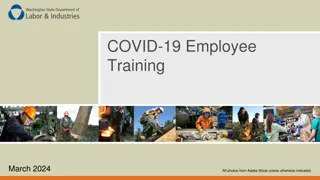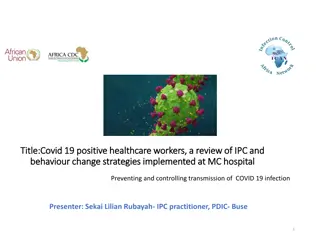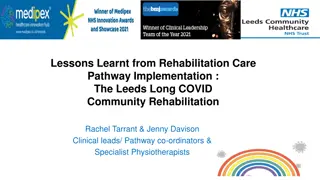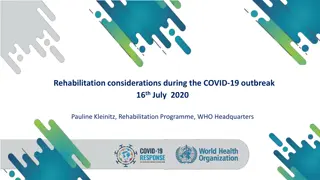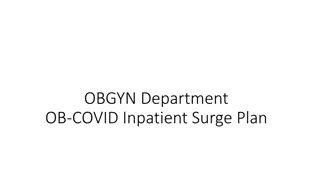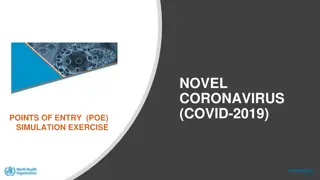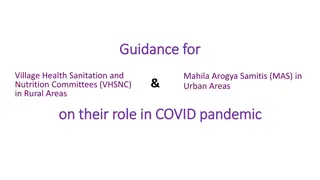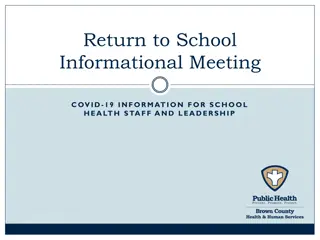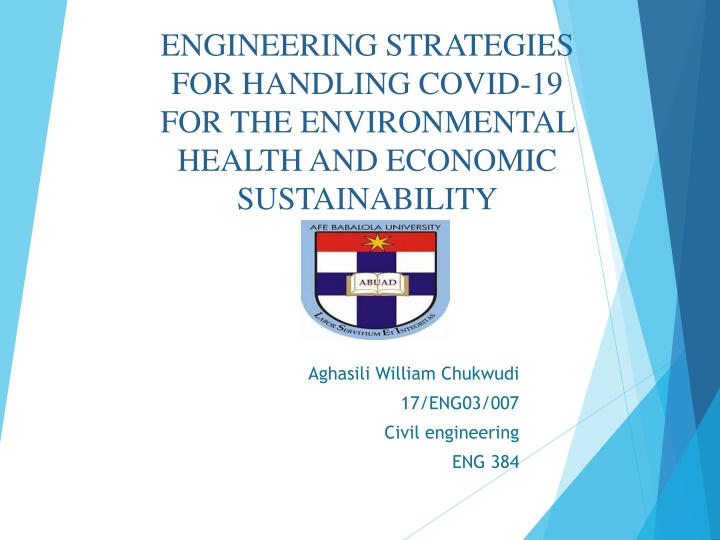
Engineering Strategies for Handling COVID-19 Impact on Health, Environment, and Economy
Explore the intersection of civil engineering, environmental health, and economic sustainability in combating COVID-19. Learn about the virus, transmission methods, preventive measures, and strategies for a sustainable future amidst the pandemic.
Download Presentation

Please find below an Image/Link to download the presentation.
The content on the website is provided AS IS for your information and personal use only. It may not be sold, licensed, or shared on other websites without obtaining consent from the author. If you encounter any issues during the download, it is possible that the publisher has removed the file from their server.
You are allowed to download the files provided on this website for personal or commercial use, subject to the condition that they are used lawfully. All files are the property of their respective owners.
The content on the website is provided AS IS for your information and personal use only. It may not be sold, licensed, or shared on other websites without obtaining consent from the author.
E N D
Presentation Transcript
ENGINEERING STRATEGIES FOR HANDLING COVID-19 FOR THE ENVIRONMENTAL HEALTH AND ECONOMIC SUSTAINABILITY Aghasili William Chukwudi 17/ENG03/007 Civil engineering ENG 384
CONTENTS INTRODUCTION/DEFINITION CORONAVIRUS (COVID-19) ENGINEERING STRATEGIES RESULTS CONCLUSION AND RECOMMENDATION
INTRODUCTION Coronavirus disease 2019 (COVID-19) is an infectious disease caused by severe acute respiratory syndrome coronavirus 2. Environmental health is the branch of public health concerned with all aspects of the natural and built environment affecting human health. Environmental health is focused on the natural and built environments for the benefit of human health. The general definition of economic sustainability is the ability of an economy to support a defined level of economic production indefinitely.
CORONAVIRUS Coronavirus disease 2019 (COVID-19) is an infectious disease caused by severe acute respiratory syndrome coronavirus 2. The disease was first identified in December 2019 in Wuhan, the capital of China's Hubei province, and has since spread globally, resulting in the ongoing 2019 20 coronavirus pandemic. Common symptoms include fever, cough and shortness of breath. Other symptoms may include fatigue, muscle pain, diarrhea, sore throat, loss of smell and abdominal pain.
The virus is mainly spread during close contact and by small droplets produced when those infected cough, sneeze or talk. These droplets may also be produced during breathing; however, they rapidly fall to the ground or surfaces and are not generally spread through the air over large distances. People may also become infected by touching a contaminated surface and then their face. The virus can survive on surfaces for up to 72 hours.
Recommended measures to prevent infection include frequent hand washing, social distancing (maintaining physical distance from others, especially from those with symptoms), covering coughs and sneezes with a tissue or inner elbow and keeping unwashed hands away from the face. The use of masks is recommended for those who suspect they have the virus and their caregivers.
ENGINEERING STRATEGIES EPIDEMIOLOGY studies the relationship between environmental exposures (including exposure to chemicals, radiation, microbiological agents, etc.) and human health. Several measures are commonly used to quantify mortality. These numbers vary by region and over time and are influenced by the volume of testing, healthcare system quality, treatment options, time since initial outbreak and population characteristics such as age, sex and overall health.
MANUFACTURING: Several measures are commonly used to quantify mortality. These numbers vary by region and over time and are influenced by the volume of testing, healthcare system quality, treatment options, time since initial outbreak and population characteristics such as age, sex and overall health. EXPERIMENTAL TESTING: Research into potential treatments started in January 2020, and several antiviral drugs are in clinical trials. Although new medications may take until 2021 to develop, several of the medications being tested are already approved for other uses or are already in advanced testing.
INFORMATION TECHNOLOGY: Big data analytics on cellphone data, facial recognition technology, mobile phone tracking and artificial intelligence are used to track infected people and people whom they contacted in South Korea, Taiwan and Singapore. In February 2020, China launched a mobile app to deal with the disease outbreak. Users are asked to enter their name and ID number. The app is able to detect 'close contact' using surveillance data and therefore a potential risk of infection. Every user can also check the status of three other users.
RESULTS GOOGLE, APPLE NEW CORONA VIRUS TRACKING SYSTEM: Apple and Google have announced they are developing a new system to track the spread of the novel coronavirus, which will help users share data via Bluetooth Low Energy (BLE) transmissions, and other apps approved by health organizations.
INNOVATIVE FACE MASK FOR THE HEARING IMPAIRED: The masks have a transparent section over the mouth for the hearing impaired to read lips. The masks also allow people to see the wearer's facial expressions, which is crucial when using Sign Language.
MECHANICAL VENTILATION: Most cases of COVID-19 are not severe enough to require mechanical ventilation (artificial assistance to support breathing), but a percentage of cases do. It has been recommended for the use of invasive mechanical ventilation because this technique limits the spread of aerosolised transmission vectors.
CONCLUSION I strongly believe that the above mentioned strategies of engineering in handling the pandemic situation are effectively been carried out to help the victims as well as the rest of the world in taking preventive measures. I also believe that the above mentioned results have also taking great effect in both sides of the world (victims and non-victims).
RECOMMENDATION With respect to the current situation, I recommend the following: People should strictly adhere to the WHO instructions and guidance. People should follow and obey the country s order and protocols.


